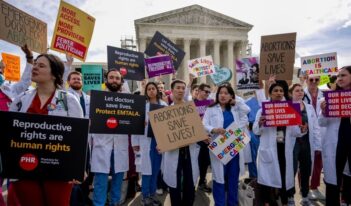
Regulations targeting abortion clinics significantly impact abortion access and public health.
Regulations designed to restrict abortion access have proliferated over the past decade.
Targeted regulation of abortion providers (TRAP) laws often subject providers to more stringent requirements than what is standard for other clinicians and impose restrictions beyond those necessary to protect patients.
Following the U.S. Supreme Court’s decisions in Roe v. Wade and Planned Parenthood of Southeastern Pennsylvania v. Casey, many states moved to limit abortion by regulating access to clinics rather than banning the procedure outright. Examples of such laws include North Carolina’s clinic humidity specifications, Louisiana’s procedure room size requirements, and Alabama’s prohibition of abortion clinics located within 2,000 feet of a school.
Proponents of TRAP laws often cite patient safety and health when enacting these regulations. However, according to the American College of Obstetricians and Gynecologists, abortion is safe in areas where it is legal. Indeed, fewer than 0.3 percent of U.S. patients undergoing the procedure experience complications requiring hospitalization. Critics argue that these regulations are aimed at shutting down providers in an attempt to chip away at abortion access—not to protect patients.
Opponents argue that requirements under TRAP laws can be unnecessarily burdensome or nearly impossible to fulfill. For example, TRAP laws often require abortion providers to pay licensing fees and maintain minimum physical dimensions of rooms and corridors, requirements that may be cost-prohibitive and arbitrary.
The public health impacts of TRAP laws have been shown to disproportionately affect people of color and lower socioeconomic status. Clinic closures across the country have resulted in longer wait periods and travel times, which place additional strain on patients in rural areas. Logistical requirements that do not improve patient safety—such as 24-hour waiting periods, mandatory ultrasounds and counseling, and informed consent laws—require patients to make multiple, sometimes costly trips to clinics. For uninsured patients, delays can increase the overall cost of the procedure and present an additional barrier to accessing quality care.
This week’s Saturday Seminar summarizes a selection of expert research on the history of TRAP laws and their effect on abortion access and services.
- The U.S. Supreme Court’s decision in 2016 to strike down a Texas TRAP law in Whole Woman’s Health v. Hellerstedt left the future of abortion access uncertain. In an article published by the UC Irvine Law Review, John A. Robertson from the University of Texas School of Law argues that, although the Whole Woman’s Health decision was “a major setback for the anti-choice movement,” the Court’s decision to invalidate the state’s TRAP laws will not stop these groups from advancing their fight against abortion access. Although the Court found considerable evidence that the law at issue imposed unnecessary requirements on providers and provided no benefits to patients, the Court left the state’s licensure and informed consent restrictions in place. As long as abortion remains a politically charged issue, Robertson cautions that “a future Court different in makeup may change the law of abortion.”
- When abortion providers are forced to adapt to regulations imposed by TRAP laws, the abortion provider workforce experiences significant strain. In an article published in Critical Public Health, Rebecca J. Mercier of Thomas Jefferson University along with Mara Buchbinder and Amy Bryant of the University of North Carolina examine how the increase in these laws has led to profound financial and emotional burdens on abortion providers and staff. Mercier and her coauthors emphasize the additional labor of complying with evolving regulations, as well as how their contributions minimize the impacts of new restrictions on patients. Mercier, Buchbinder, and Bryant argue that the continued proliferation of TRAP laws imposes significant obstacles for both clinicians and their patients by creating barriers to accessible and quality care.
- Do TRAP laws account for declining abortion numbers between 2011 and 2017? In a paper for the Guttmacher Institute, Elizabeth Nash and Joerg Dreweke argue that there is a “clear link” between TRAP laws and abortion clinic closures, but no “clear pattern” linking TRAP laws to lower abortion rates. Instead of decreasing abortion rates, Nash and Dreweke argue, TRAP laws create hardships for people seeking abortion, including emotional consequences, delays in obtaining care, and diversion of money meant for other necessary expenses, such as rent, groceries, or utilities. Nash and Dreweke argue in favor of policies that dismantle the “legal, logistical and financial barriers to abortion,” which are “largely borne by low-income individuals, people of color, and young people.”
- Although proponents argue that TRAP laws reduce abortion demand by making it more difficult to obtain an abortion, Marshall Medoff from the California State University, Long Beach empirically refutes this contention. In an article published in the Review of Policy Research, Medoff analyzes abortion data from 1982 to 2005, focusing on the impact of laws that require abortion providers to pay annual licensing fees, meet structural or physical dimensions requirements, or employ personnel with certain qualifications. Medoff finds that these types of requirements did not have a “statistically significant independent effect” on demand for abortion during that time frame.
- In a recent American Journal of Public Health article, a research team compared regulations on facilities providing surgeries and procedures outside of hospitals, known as office interventions, with those regulations specifically impacting facilities providing abortions. Bonnie S. Jones and Sara Daniel, of Advancing New Standards in Reproductive Health, and Lindsay K. Cloud, of the Policy Surveillance Program of the Center for Public Health Law Research, report that, although TRAP laws only regulate a “small subset of office interventions,” they have more requirements and broader application than laws generally covering office interventions. In addition, they found that states have passed more than two times more TRAP laws than laws that target abortion-related medical care given by a general office care provider. Challenges to TRAP laws may be more successful following the Supreme Court’s decision in Whole Women’s Health, as these regulations of abortion-providing facilities appear to “go beyond necessary and accepted standards of practice,” according to Jones, Daniel, and Cloud.
- Although administrative regulation of abortion focuses on health concerns and seems to open the door to gender-based equal protection challenges to TRAP laws, “this appearance is deceptive,” argues Columbia Law School’s Gillian E. Metzger in an Emory Law Journal article. She explains that TRAP regulations may seem vulnerable to equal protection challenges because they single out “procedures used only by women for distinct and disfavored treatment.” But Metzger claims that because these laws are framed as health protections, courts tend to defer to the government on how it exercises its broad power to regulate health matters. Instead of challenging TRAP laws on equal protection grounds, Metzger advocates using “straightforward administrative law terms” to challenge measures targeting abortion. Administrative law’s “requirements of explanation and reasoned decision-making” could “offer the greatest protection against regulations that single out abortion for disfavored treatment,” she writes.
The Saturday Seminar is a weekly feature that aims to put into written form the kind of content that would be conveyed in a live seminar involving regulatory experts. Each week, The Regulatory Review publishes a brief overview of a selected regulatory topic and then distills recent research and scholarly writing on that topic.



